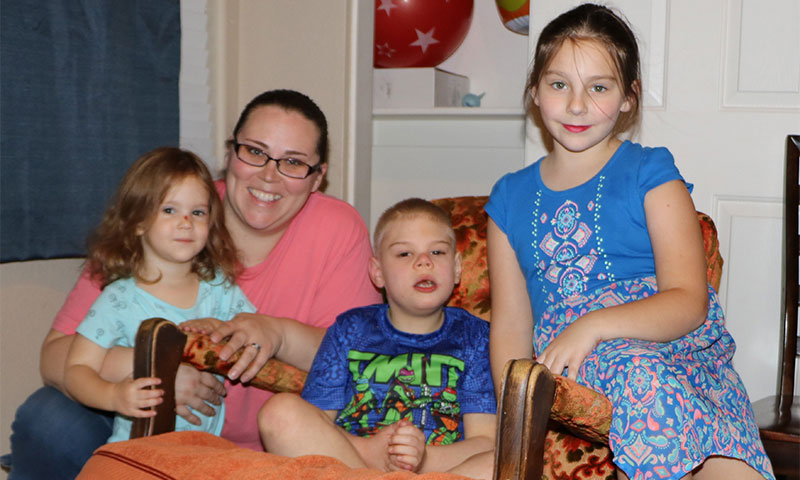On Their Own, But Not Alone
How DDD Supports Families With Limited Options
Ten years ago, Porter Merrill, was born. Although a full-term baby, within five days of birth, his mother Betty, knew something was wrong. The first symptom was that her son had trouble nursing.
“It would take him about an hour to get an ounce of food,” said Merrill. Born at seven pounds, one ounce, little Porter lost 22 percent of his body weight during his first week of life. His pediatrician assured the new parents that all was fine, but “I knew there was something majorly wrong with him,” said Merrill.

Surrounding 10-year-old Porter Merrill are (from left) Samantha (age 2), mother Betty, and Ella (age 8).
One day at church, Merrill met a woman who works at Phoenix Children’s Hospital’s newborn intensive care unit. Porter was seven weeks old when Merrill had the church member examine him. She noted the infant was severely dehydrated, detected a heart murmur among other symptoms, and advised Merrill to take little Porter to the ER immediately.
Hospital staff ran a number of tests including ultrasounds on Porter’s heart and brain, and a magnetic resonance imaging (MRI) scan. The brain scan revealed a problem with Porter’s corpus callosum. The corpus callosum lies between the brain’s two hemispheres. Each hemisphere has dedicated functions. Physical coordination and taking in complex information requires both sides of the brain to work together, and the corpus callosum serves as the main communications bridge between the two hemispheres. Instead of being the usual size of a baby’s fist, Porter’s corpus callosum was smaller than a thumbnail. Among the potential symptoms of this disorder are low muscle tone, difficulty feeding, seizures, difficulty with problem-solving and complex tasks, and delays in developmental characteristics, such as sitting, walking, speech, and poor coordination.
A geneticist also discovered that Porter had a rare, partial deletion of chromosome 1 part Q44. According to Unique, a charity that serves individuals affected by a rare chromosome disorder, some of the most common features of this deletion include low muscle tone, seizures, feeding difficulties, short stature, heart conditions and learning disabilities. There have only been 50 reported cases of a 1q4 deletion since the first published diagnosis in 1976.
Still experiencing feeding problems at six months of age, Porter underwent surgery to insert a permanent gastrointestinal tube and another surgery to alleviate a double inguinal hernia in his groin. At that point, a neurologist was called for expertise in that area. Merrill recalls the neurologist asking the young couple what kind of resources they had.
“No resources. We have no family here, nobody really to help us,” replied Merrill. “So, she told us about DDD,” Merrill said with a smile.
DDD is the acronym for the Division of Developmental Disabilities. DDD provides services and supports to individuals with developmental disabilities and their families. The mission of DDD is to empower individuals with development disabilities to lead self-directed, healthy and meaningful lives.
“We got approved for DDD and we started getting services when [Porter] was about seven months old. It was actually a pretty quick process because the neurologist helped us fill out all the paperwork.”
An early intervention specialist with DDD developed an Individualized Family Service Plan, and arranged for Porter to receive physical, occupational, speech and feeding therapies.
“They were just amazing!” exclaimed Merrill. “We just had amazing therapists.”
“The early intervention specialist really brought all the therapies together,” said Merrill. “She just made it so cohesive. She coordinated services of all the therapists and worked to reinforce what they were doing.”
“The early intervention specialist was so upbeat and so happy all the time,” reported Merrill. “Because of that happiness she was able to get him to do things. She is the one that got him to finally start holding his head up when he was about nine months old. And, she got him to roll over for the first time when he was 11 months,” said Merrill.
Thanks to physical and occupational therapies, Porter started crawling the night before his second birthday. Now at age 10, He can pull himself up to stand, cruise along the furniture and hold his toys. Porter still can’t walk on his own “because that’s his brain – it has nothing to do with the therapists, because they have been amazing,” said Merrill. “With many of the therapists, you can tell they’re not in it for the money – they’re in it for the kids.”
Reflecting on the past 10 years, Merrill said, “I don’t know what we would have done if we hadn’t had all these services. [Porter] wouldn’t be where he is today without all the services we’ve received. We’ve really been blessed by having DDD.”
By Lyn Riley

